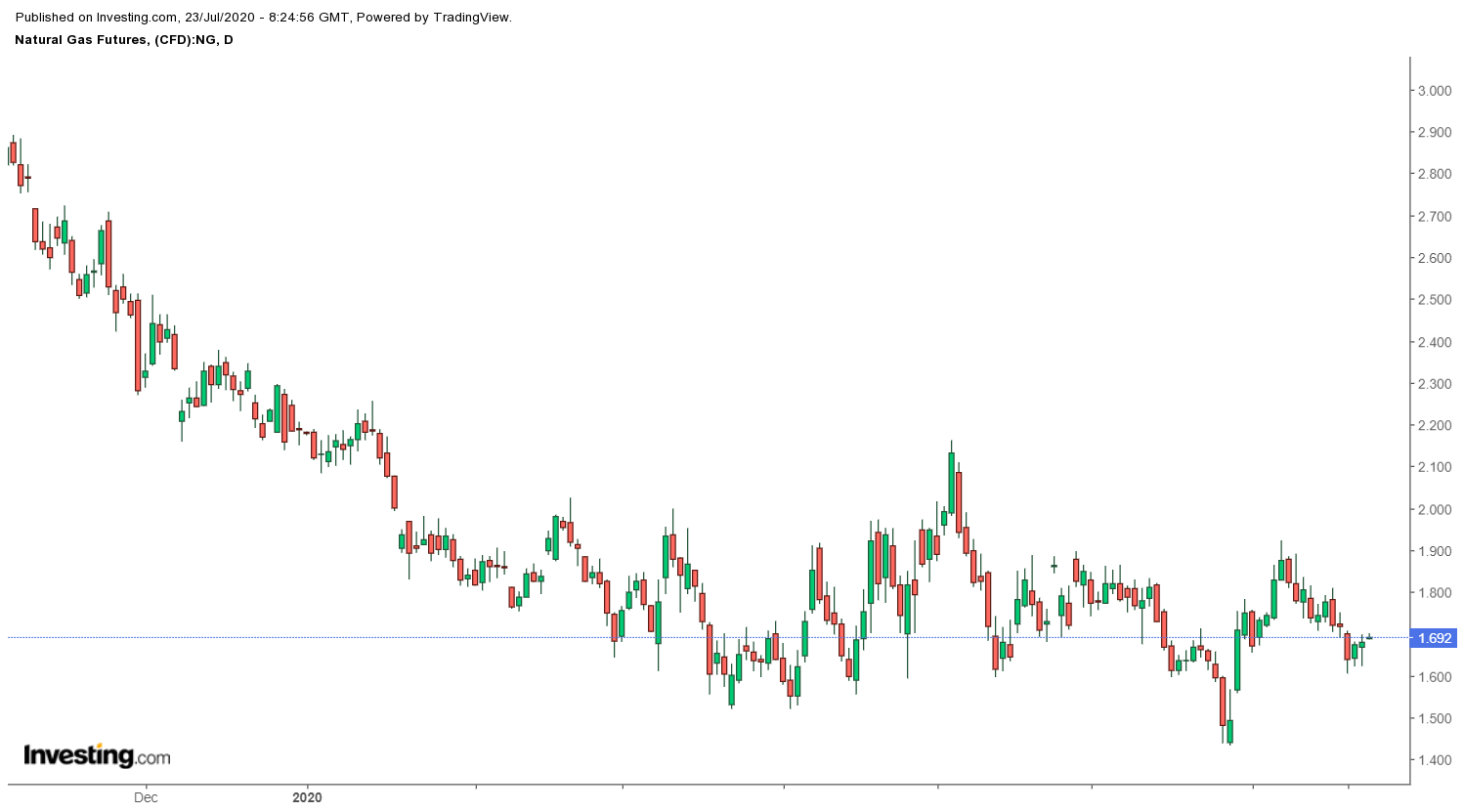Street Calls of the Week
Another weekly update on US natural gas demand is due today. Forecasts are for an unseasonably small build, and if these are accurate, they should alleviate some of July’s pain for the long-suffering natural gas bulls.
"Should”—because a change in the weather forecast for cooler mid-summer temperatures is dampening expectations for demand for air-conditioning that is key for supporting prices.
Additionally, new cancellations of liquefied natural gas cargoes are weakening the demand side story in gas.
While benchmark September Henry Hub gas futures have risen over the past two sessions, they remain down more than 1% on the week after Monday’s near 5% slump.

As for the gas balance, analysts expect the Energy Information Administration to report that utilities injected 36 billion cubic feet (bcf) into storage during the week to July 17, down from 44 bcf during the same week a year ago and below a five-year (2015-2019) average build of 37 bcf for the period. In the previous week to July 10, there was an injection of 45 bcf.
Market Has Managed To Avoid Meltdown Since June
Since April’s outsize price gain of 19%, the benchmark futures contract has fallen for three successive months, losing 13% in the process. In June the price hit a 25-year low of $1.518 per million metric British thermal unit (mmBtu). The price is down 3% so far in July, around $1.69 per mmBtu.
“So far, the front month has managed to stave off a total collapse back to last month’s lows, but it is unclear how long this will hold, as downward pressure on next month mounts,” said Dan Myers, analyst at Gelber & Associates, in an email to clients of the Houston-based gas risk consultancy on Wednesday.
Above-normal temperatures over late June and much of July, combined with gas prices that were initially driven lower by declining usage due to the coronavirus pandemic, have increased demand from utilities for power burns and have helped erode some of the surplus, naturalgasintel.com noted in a report.
Until last week—and before temperatures cooled this week—the weather was hotter than normal, with 100 cooling degree days (CDDs) noted for the week to July 17, compared with a 30-year average of 87 CDDs for this same period.
CDDs, used to estimate demand to cool homes and businesses, measure the number of degrees a day's average temperature is above 65 degrees Fahrenheit (18 degrees Celsius).
Bespoke Weather Services said its outlook showed evidence of a “cooler trough” moving into the eastern half of the nation late this month into early August.
“We believe this is temporary and that heat can return to the East as we move deeper into August, but the cooler momentum may not be finished yet."
“As such, we remain on the cool side of guidance.”
Production Modest As Well
US gas production, while up from the lows of last spring, has hovered recently near a modest 85 bcf/d, with an anticipated return of associated output from shuttered oil facilities yet to fully materialize.
The EIA has projected both gas production and demand will drop in 2020 and 2021 from record highs last year, as lockdowns around the world to slow the spread of coronavirus cut affect economic activity and energy prices.
A force majeure on Columbia Gas' Mountaineer XPress Pipeline also cut Appalachian gas production by over 2.2 bcf daily in the first week of July, briefly sending Henry Hub prices to a two-month high. That has since been resolved.
Now, Myers said, unseasonably cool temperatures have been forecast in Texas, the Mid-Continent and interior East of the United States, potentially reducing the need for air-conditioning.
“Additionally, a new swath of LNG cargo cancellations are making clear expectations of continued demand weakness in that sector through at least September."
According to Myers, current forecasts are for cargo cancellations of between 15 and 26, with more than half of those coming from Cheniere facilities in the Gulf Coast of Mexico and many of the rest from Freeport LNG in Texas.
Scott Shelton, energy futures broker at ICAP in Durham, North Carolina, concurred with Myers:
“I have yet to hear a definitive cancellation amount for (the Sabine Pass LNG terminal at Cheniere) for September, but my guess is somewhere around 25 cargoes."
Reuters reported about 40 to 50 cancellations of US LNG shipments were reported for July and August, citing market sources.
LNG Remains A Worry
Myers wrote that LNG terminal utilization may improve as fall approaches:
“However, with the tally now over 150 cancelled cargoes since spring, the market may not find much optimism in the reduced number."
LNG feed-gas demand hit its lowest levels since February 2019 early this month and has only recovered slightly since then to a current seven-day average near 3.7 bcf/d.
Markets have, for weeks, counted on high temperatures to drive cooling demand and use up some of the excess gas in storage ahead of the fall to avoid containment challenges.
While most of the 50 states have lifted restrictions imposed to slow the spread of COVID-19, new outbreaks of the virus have since led to a resurgence in cases that threaten to derail the recovery.
Several states and cities have paused business reopening plans, and some have ordered new restrictions. California, Florida and Texas—three of the most heavily populated states in the country—have, for example, reinstated restrictions on indoor events and group activities.
“A retreat in states’ reopening directives will likely have a dampening impact on the recovery,” Raymond James & Associates Inc chief economist Scott Brown told naturalgasintel.com. “Risks to the economic growth outlook remain weighted to the downside.”
Recoveries in Europe and Asia—key destinations for US LNG exports—also remain vulnerable, leaving markets generally dubious about demand drivers beyond robust heat for the remainder of the northern hemisphere summer.
Disclaimer: Barani Krishnan does not own, or hold positions, in the assets he writes about.
